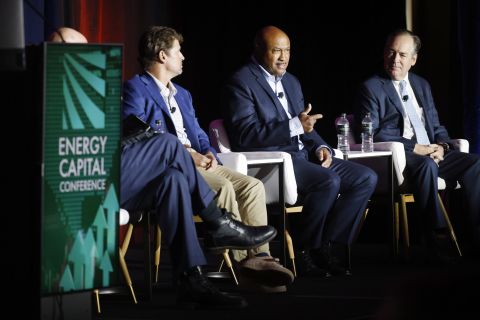The ongoing sovereign debt crisis in Europe and weakening economic data in China are stirring volatility in the global equity markets. These factors have impeded full recognition of the underlying secular growth story in many subsectors of the energy market, especially the North American E&P space, where equity valuations are severely discounted from fundamentals.
Amid weak stock prices relative to net asset values, another contributor to E&P volatility in 2011 was the heightened expectation of corporate mergers and acquisitions or spin-offs. With, on the one hand, deep-pocketed foreign companies seeking long-lived resource inventories, and, on the other, a host of capital-constrained E&Ps with high-quality yet undeveloped unconventional resources, the circumstances seemed ripe for marriage.
Indeed, many companies, such as Quicksilver Resources Inc. and Exco Resources Inc., put themselves up for sale in 2011, though they found no buyers. Others, such as Petrohawk Energy Corp. and Brigham Exploration Co., merged with foreign conglomerates for significant premiums. Predictions of corporate-event catalysts were actively used in shaping investment theses and capital allocations throughout the year.
As a result, North American E&P stocks experienced very high beta with price fluctuations of 2% or more on 36% of trading days in 2011, according to analysts at Société Générale S.A. And their share of NYSE trading volumes was even greater than other typically high-beta energy subsectors, such as oilfield services.
Resilient crude oil prices (front-month West Texas Intermediate, +8%), helped energy stocks to beat the broader markets in 2011 (S&P 500 Energy Index was up 3% versus the S&P 500, unchanged). However, this outperformance was driven by strength in the supermajors (S&P 500 Integrated Index, +12%), while independent producers lagged (S&P 500 E&P Index, -7%).
The relative weakness and volatility among E&P stocks make them difficult for long-only, low-turnover fund managers to own, because their hedging options are limited and short-term results are increasingly scrutinized by skittish investors. In other words, underperformance and volatility beget more of the same, as the more stable long-term investors rotate capital into other spaces, and as the capital that flows into E&Ps reflects higher-frequency traders.
In fact, assets under management at all equity funds dropped by $186 billion for 2011 through December 12, according to Thomson Reuters’ Lipper data, while money held in taxable bond funds rose by $69.8 billion, reflecting investors’ underlying bearishness.
The volatility is keeping the IPO market simmering. Three E&Ps, five services and manufacturing companies, and a refiner have filed and are waiting so far. All filed in 2011 and, presumably, are waiting for a less volatile window or for the windows in the covenants to take effect.
If 2011 was a frustrating year for equities, with investors demonstrating caution, what does that portend for 2012? Something of a self-fulfilling prophesy, since there does not appear to be much appetite from value investors to buy these recent dips. With the amount of long-term equity assets under institutional management diminishing, the stock market is increasingly dominated by hedge funds and exchange-traded funds (ETFs), which trade E&Ps indiscriminately, with little regard for financials and resource potentials.
More fundamentally, with the problems in Europe unresolved and the Chinese economy apparently cooling, there are cyclical risks to energy demand.
Concern about the European banking crisis is already spreading, with potential impact on domestic energy lending in 2012. Some of the European institutions, particularly the larger banks, are an active part of the North American syndication pool. Though the number of European banks participating in domestic energy lending is few, they had been ready and able to take large financial exposures with domestic oil and gas companies to this point.
There is concern now about the ramifications for capital access should players exit the market or reduce their commitments.
Domestic lenders generally do not believe this scenario is a major threat to capital access, as they anticipate smaller lenders will step up or new entrants will fill the void. But a reshuffling could ensue. And, regulation could meaningfully impact cost of capital, as the global banking industry moves towards Basel II and III compliance.
Energy lenders are waiting for the spring lending price decks for more clarity. All indications point to a mild winter that could turn colder, but too late for the gas market. Some lenders are contemplating a $2 natural gas handle in 2012 and expect more downward pressure on price decks in the spring, despite nebulous long-term gas bullishness.
On the corporate side, recently released 2012 capex outlooks and guidance pose downside risk to 2012 production and cash-flow estimates, as costs continue to rise and E&Ps persist in outspending cash flow. And the impact of the substantial capital spending already in place is as yet unknown, as the Bakken, Eagle Ford, Niobrara, Utica, Permian Basin and other oil- and liquids-focused plays are poised to contribute meaningful oil volumes to the world market in the years ahead.
Regardless, how these factors will play out is well beyond the investment horizon of most of today’s equity market participants.

Recommended Reading
Optimizing Direct Air Capture Similar to Recovering Spilled Wine
2024-09-20 - Direct air capture technologies are technically and financially challenging, but efforts are underway to change that.
Carbon Removal Company Equatic Appoints New CEO
2024-11-18 - Equatic appointed a new CEO in preparation to launch the world’s largest ocean-based carbon removal plant.
Hunting Wins Contracts for OOR Services to North Sea Operators
2024-08-29 - Hunting is securing contracts worth up to $60 million to deliver organic oil recovery technology to increase recoverable reserves for North Sea operators.
Sheffield: E&Ps’ Capital Starvation Not All Bad, But M&A Needs Work
2024-10-04 - Bryan Sheffield, managing partner of Formentera Partners and founder of Parsley Energy, discussed E&P capital, M&A barriers and how longer laterals could spur a “growth mode” at Hart Energy’s Energy Capital Conference.
Post Oak Backs New Permian Team, But PE Faces Uphill Fundraising Battle
2024-10-11 - As private equity begins the process of recycling inventory, likely to be divested from large-scale mergers, executives acknowledged that raising funds has become increasingly difficult.
Comments
Add new comment
This conversation is moderated according to Hart Energy community rules. Please read the rules before joining the discussion. If you’re experiencing any technical problems, please contact our customer care team.





